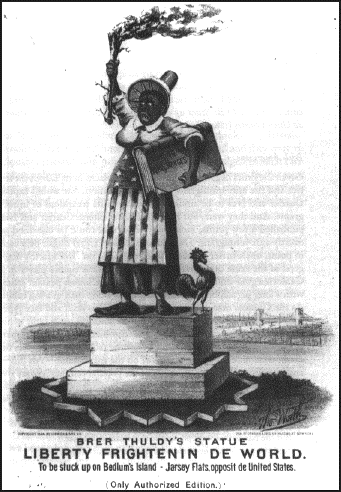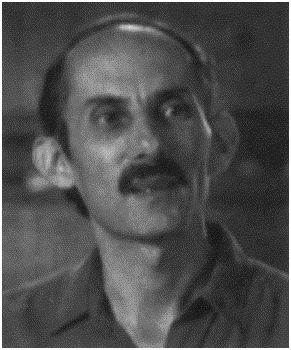Nathaniel Currier and James Merritt Ives referred to their company as the "Grand Central Depot for Cheap and Popular Prints." They began in 1835, years before photographs came along to compete with them. In the sixty or so years of their existence, they produced thousands of pictures, prints of urban and rural life in America. Most of their lithographs were so comfortable they could well be considered the Saturday Evening Post of their day. They featured political cartoons and representations of major current events: their first real success was a picture of a pleasure-boat which went down in New York Harbor in 1840, entitled Awful Conflagration of the Steam Boat "Lexington!"
Their later works sold in the millions, but their record lies tarnished --- at least for current sensibilities --- with degrading pictures of the Irish, Oriental immigrants, and, most commonly, Blacks. In a series of 100 prints entitled "Darktown," Blacks are shown as ludicrous, incapable of even running a horse race or going on a picnic without inviting disaster. As the author points out, it was a sign of the times:
It is no accident that the series appeared at a time when scientists and social scientists were propounding the natural inferiority of African Americans and the inappropriateness of their attempting to live in the white man's world --- presuming to live above their true station in life, even putting on airs in the process.
 It's a suitably fascinating subject, but there are major difficulties with this Smithsonian presentation. The quality of the prints is deplorable. The cuts are dark, smudgy, and so fogged-out that captions are often impossible to read.
It's a suitably fascinating subject, but there are major difficulties with this Smithsonian presentation. The quality of the prints is deplorable. The cuts are dark, smudgy, and so fogged-out that captions are often impossible to read.
In addition, out of the estimated 7,000 lithographs produced by Currier and Ives, only fifty or so appear in this book. Because there are so few illustrations, in his 400 pages, the author is reduced to citing prints, describing them to us with words instead of showing us the real thing. For example,
In Hiawatha's Wooing, the first in the series chronologically, Hiawatha, the semilegendary chief of the Onondaga Tribe --- said to have founded the Iroquois Confederacy --- lays a dead buck on the ground before Minnehaha. Minnehaha sits next to her father in front of their teepee. The subject is a good one for Longfellow and Currier and Ives to romanticize because Hiawatha was said to have lived in the fifteenth century, among a tribe that no longer posed any threat to nineteenth-century Americans.
When the author writes above that he "lays a dead buck on the ground," and since a "buck" was once the common, vulgar name for an Indian --- we figured that to prove the depth of his passion for Minnehaha, Hiawatha had gone out and butchered a fellow Indian to lay out before her.
We would think that the august Smithsonian, with all its resources, should be capable of producing a volume with 200 - 300 prints, reproduced in high quality, which would correspondingly minimize this somewhat specious text.
Jack Kornfield is one of the grand old men of American meditative practice and teaching. He's been around for twenty-five years or so, and when he isn't in India, or Sri Lanka, or Thailand, he's writing books and giving lectures and doing retreats on Buddhism.
These six tapes were drawn from a five-week session in Marin County. They consist of brief remarks by him on the history and traditions of Buddhism, some personal observations, then a guided meditation, followed by feed-back from the audience.
There is emphasis on mindfulness. We begin with the breath, then move on to whatever aches and pains (or ecstasies) that are afflicting the body during meditation. There is a twofold purpose. The first it to be aware. The second is to not try to change anything. Thus if after ten minutes of meditation, one has an itch on the bum, one doesn't scratch: one thinks "itch on bum," then goes back to watching the breath.
Or if one is meditating, and feelings of anger pop up, one says to oneself, mildly, "anger" --- and then one stays with that anger until it dissipates. In the act of saying "anger," one strives to not get caught up in it. One merely observes the feeling. Which is, after all, nothing. And everything.
§ § §
Kornfield knows his stuff, and he knows how to present it in an informed yet informal manner that can be, in a manner of speaking, enlightening. He also manages to make the process of meditation more accessible to those of us who have been trying to get the hang of it without success over the years.
He gives specific instructions on how to deal with restlessness, or sleepiness, or even ecstasy. For instance, if you are meditating and suddenly feel you are beginning to float off your cushion, he suggests that you open your eyes to reassure yourself that you are still firmly grounded.
His stories are drawn from his own experience, as well as Sufi tales, Hasidic stories, quotes from the followers of Buddha, and even from Las Vegas, this last being a sign that says,
which, he tells us, can apply to Buddhism as easily as Lotto.
§ § §I listen to these tapes in the car, and there are enough jam-ups there on the outskirts of Yonkers that I get to spend an hour or more working on my car karma until the truck ahead of me jams on its brakes at which time I find I have just enough time before the big smash-up to label what is happening to me and my body as "naked fear."
At one point in the early days of listening to these tapes, I found myself floating off --- not off my cushion but back to memories of a history teacher I had at Bryn Mawr College, back fifty or so years ago."
Our professor was famous, and very distinguished. His specialty was Russian History from the time of the Tartars. Since I was a history major, I signed up for two back-to-back classes with him. When the first class began, I found out that our quite-famous professor had a lisp --- a lisp that was so strong that during the first hour I could scarcely figure out what he was saying. "O God," I wondered, "How am I going to get out from under this one?" I was worried about how to explain it to my advisor. What if they were friends? Then there was the question of being genteel. Wouldn't it be bad breeding to bring it up? I worried a lot about those kinds of things in my salad years.
Well, Professor Lisp turned out to be such a dynamite teacher that by the end of the first week we --- my classmates and I --- had completely forgotten his speech impediment. By the end of the month most of us had ourselves begun to speak in dignified, upper-class lisps.
I bring all this up because when I first started in on Tape #1, Kornfield's speech patterns came across not like some guru master but a juvenile delinquent from the Bronx. His voice reminded me of a radio program about a 50s teen-ager named Henry Aldrich. When his mother called --- or bellowed --- "Henry. Henry Aldrich!" his cracked-voice response, "Coming, Mother," was supposed to be very funny. And although I suspect that Kornfield is way past puberty, he speaks more Henry than (say) Alan Watts or Ram Dass.
However, by the third session, when he told us from personal experience how to do fifteen minutes of meditation with a fly crawling around on your face, or when he delivered the story of his master telling him to meditate sitting on the edge of a well (he kept falling asleep in meditation; his master thought that being on the edge of a forty foot drop might cure that; he was right) or when he described getting pissed at his master ("You're supposed to be enlightened! Yet you constantly contradict yourself!") --- after these tales, he had won my heart, and now I find that I, too, am beginning to talk more and more like Henry Aldrich.
§ § §
The major problem with "The Inner Art of Meditation" is a technical one. The engineering types who do the recording for Sounds True could have done a better job on the placement of their sound equipment. Kornfield is speaking before an audience, and their sometimes all-too-raucous laughter --- he can be quite funny --- is very distracting to those of us in the meditative position trying hard to just listen. By the simple placement of a couple of extra microphones, the engineers could have soft-pedaled this noise and, at the same time, could have the freedom to crank up the volume when the audience is delivering questions or statements (and then crank it back down when Kornfield responds). As it is now, the questions from his audience often come across as mysterious whispers in the far background. Could it be, perchance, the sound of the one hand clapping?

 It's a suitably fascinating subject, but there are major difficulties with this Smithsonian presentation. The quality of the prints is deplorable. The cuts are dark, smudgy, and so fogged-out that captions are often impossible to read.
It's a suitably fascinating subject, but there are major difficulties with this Smithsonian presentation. The quality of the prints is deplorable. The cuts are dark, smudgy, and so fogged-out that captions are often impossible to read. 